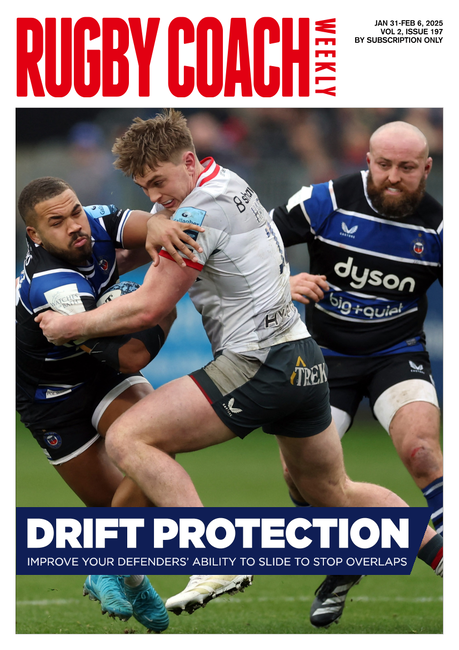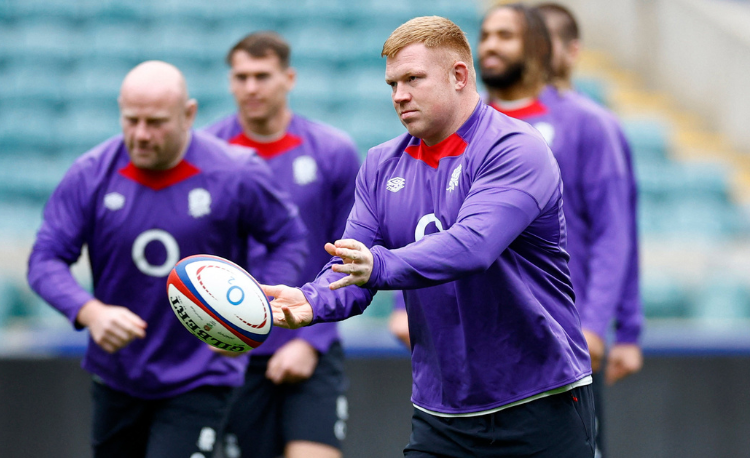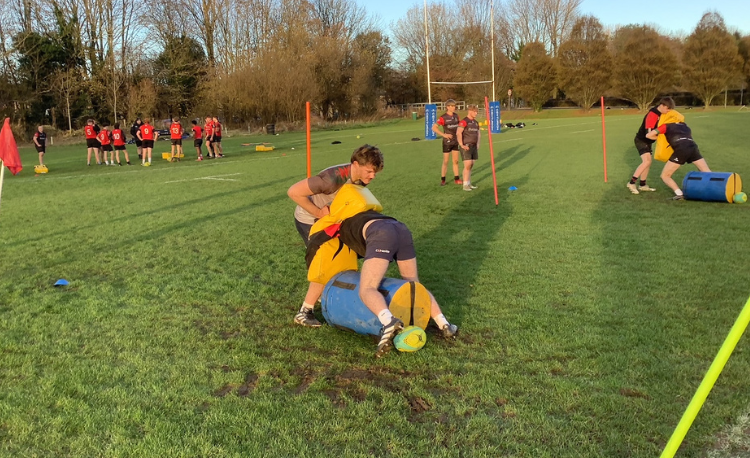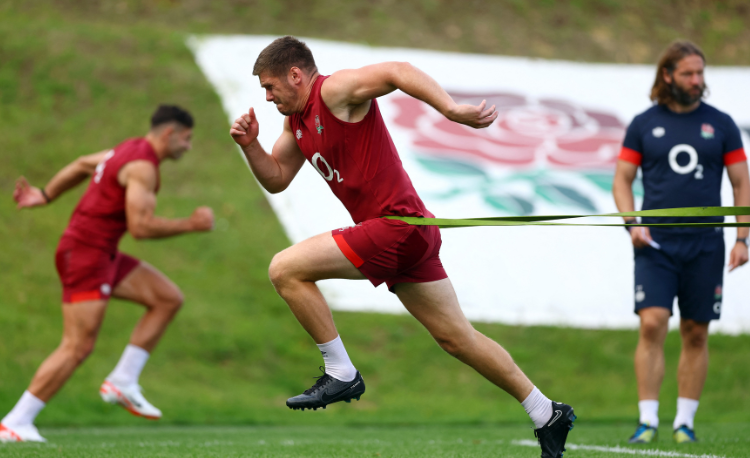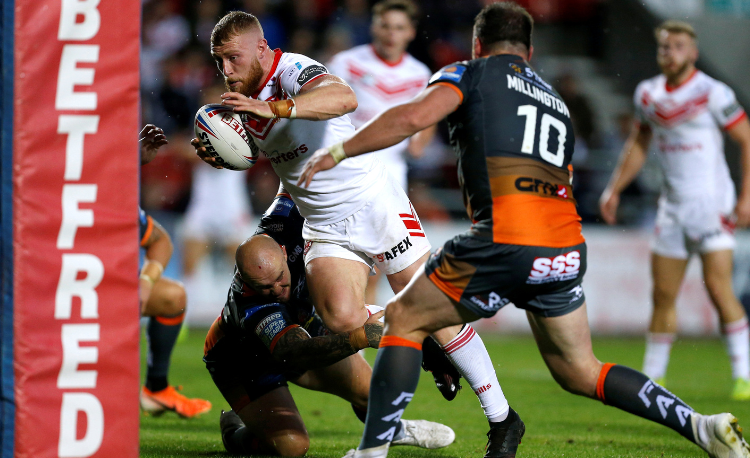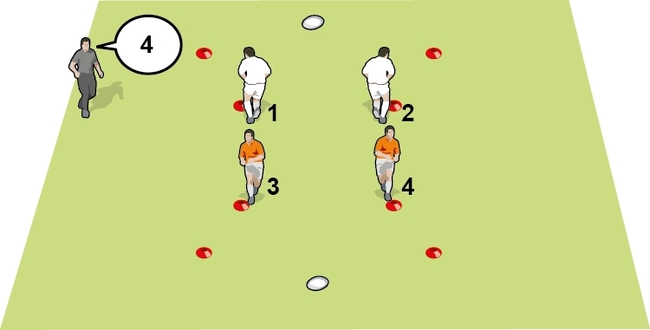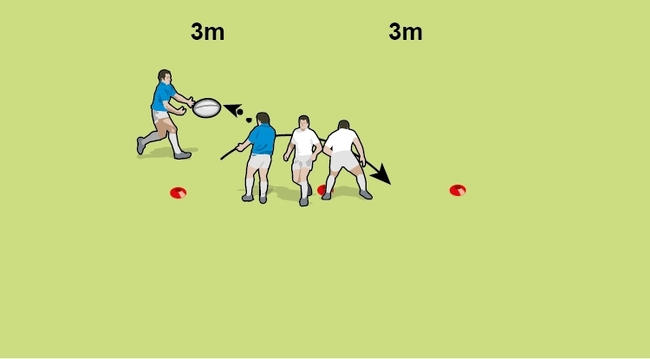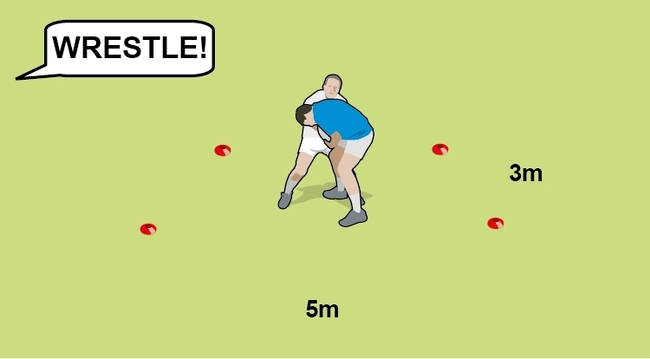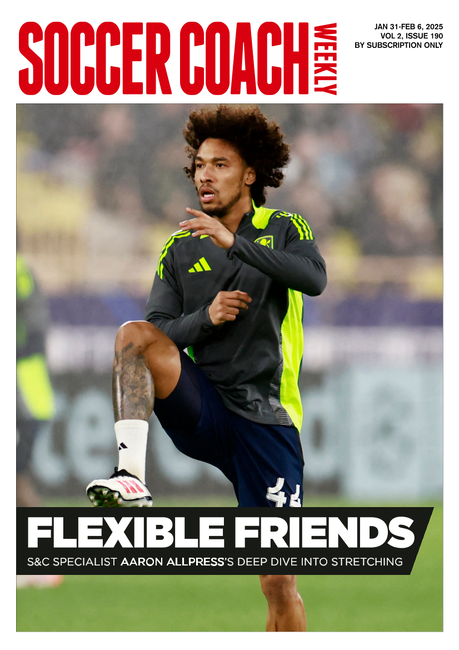Rugby League skills into rugby union
Because league concentrates on fewer skills, these skills are highly-tuned and detailed. Denis Betts, a much-decorated player, incorporated his league background into the coaching routine at Gloucester. Here's how.
Rugby league is a catch, pass, run, kick and tackle game. There is little chance for a contest for the ball, apart from a high ball kick or a kick and chase while union has scrums, lineouts, rucks and mauls.
Possession in league is different to possession in union. In the former, teams can hold onto the ball for six tackles and do not even need to pass the ball for those six tackles. If the ball carrier “loses” a tackle, the team retains possession and the tackled player does not need support to ensure the ball is presented again.
In the latter, the gain line and field position are as important as possession. In fact, too much possession in union can be a bad thing. After six or seven phases, the attacking shape may be lost, too many forwards can be on the ground or in rucks and the defence are in a strong position to turn over the ball.


To make possession really count, the ball carrier must be crossing the gain line, forcing pressure onto the defence. A defence on the back foot, or a defence struggling to get back into position can be broken down more easily. Going forward in possession means you can force errors in defence. Going backwards in possession has the reverse effect.
Attack is tough though. To win back possession at the rucks, you might need three or four forwards. If defences only commit one player plus the tackler to each contact then there is a mismatch. A savvy defending team might continue to keep this commitment to rucks low until they feel they can dominate the next ruck and then they flood through to turnover the ball.
So, the key in possession is not about keeping the ball, it is what you do when you have it. Look at each attack and see where you end up.
Coaching is about creating habits in players – repeatable skills accurately performed under pressure. I set up systems at Gloucester to work on the core areas of handling, running and tackling. Hard graft on the basics means players can make the split-second decisions which can lead to linebreaks or close down attacks.
For instance, I worked on better handling techniques. One area I found needed particular attention was the use of the thumb. Catching is taken for granted by many players and they forget the significance of the thumb to help them catch the ball and then carry it.
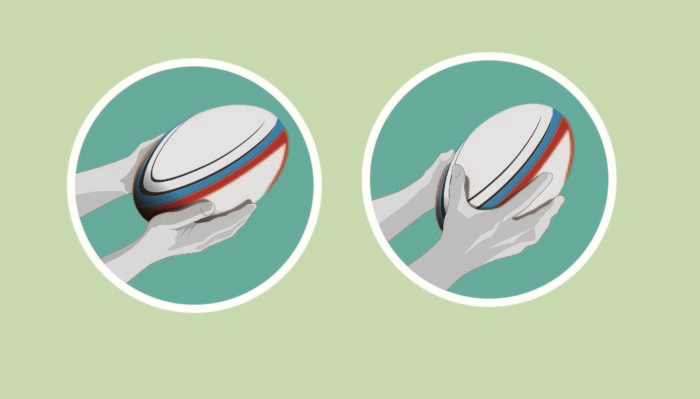
Make sure players are carrying the ball with fingers spread across it. More use of the thumb gives better control of the catch and pass
Some players will catch, carry and pass as if their hand is a paddle. To coach it well, I first made players aware of the importance of using the thumb. I then outlined the benefits (control, more successful catch and pass). Once they are convinced of the benefits, they are happy to practise hard to improve and make it a habit.
Putting skills into game situations, I work on rugby decision making: That is positioning opposition players so that you can dominate them. In attack that means either beating them in the collision, avoiding them or fixing them so you can pass to another attacker in space.
In defence, that means either manipulating the ball carrier before they reach contact, or if they come into contact, the best tackle to use.
In league we concentrate on the ball carrier positioning the defender by his angles of run. Defenders come from different angles in matches and ball carriers have to know how to fix a player who is front of them (the most regular training scenario), and from the side, behind them and at different paces.
We continually revisit 2v1 situations in training. The ball carrier has to know what is in front of him and understand how the defender might move. He uses his eyes to make the defender move and know where the support player is.

A 2v1 is a culmination of plays which might start from say, a 5v5. Again, training needs to create situations where players work on their linebreaks, making them and then finishing them off. These sort of details get lost in training sessions because we have to revert back to working on set pieces all the time. Yes, they are an important part of gaining possession but you must score when you make a linebreak.
In the tackle, we want the defender to dominate the ball carrier. He needs to change the centre of gravity of the ball carrier to topple him over. He does this by tackling between the hips and knees, squeezing hard as he does so or targets through and under the ball.

The best tacklers tip the ball carrier over their centre of gravity, either by squeezing the knees or targeting around the ball.
The best tacklers choose which is best. It is no good being a speed bump for the ball carrier to run over if the tackler becomes planted. He has to change his line and direction – and like a good attacker, manipulate the ball carrier.
However, for all the detail we can give a player, if the defender gets the player to the ground, then the processes may not matter. Some players defy normal skills. Should their technique be successful, don’t change it. Help him understand why it works and let him build on that. It is not what I believe is the right way to play the game but what I can make them believe that matters.
It is better to focus on what is better to make it even better. Too often we are working on what is going wrong. The bad things will improve as we make the player better at what he does well. And with that focus, the better things will not be forgotten when it matters.
I make the player remember why he is a good player, what put him into the team or squad in the first place.
A short passing game will create the opportunities for linebreaks and completing 2v1s.
Spin passing still has a role to play but we need to work on the detail of quick, accurate short passes. These passes are easy to catch, allowing the receiver more time to make his next decision.
I think we are spoilt by new ball technology making players lazy passers because there is so much grip on the ball. In the old days, we didn’t see long spin passes. Instead, players had to push the pass because the ball was heavier and less sticky. Short passes are really push-passes. The player should have the sensation of squeezing the ball through his fingers and towards the target.


Denis played rugby league for Great Britain (32 caps), as well club rugby for Wigan and the Auckland Warriors. He finished playing in 2001 and coached at Wigan where he became assistant coach in 2003, taking temporary charge for a year to cover for illness. He switched codes in 2006, moving to English Premiership side Gloucester. He was the skills and development coach for four years. He then returned to league, helping Widnes Vikings to Super League status for the 2012 season.
A difference in possession and field position
Rugby league is a catch, pass, run, kick and tackle game. There is little chance for a contest for the ball, apart from a high ball kick or a kick and chase while union has scrums, lineouts, rucks and mauls.
Possession in league is different to possession in union. In the former, teams can hold onto the ball for six tackles and do not even need to pass the ball for those six tackles. If the ball carrier “loses” a tackle, the team retains possession and the tackled player does not need support to ensure the ball is presented again.
In the latter, the gain line and field position are as important as possession. In fact, too much possession in union can be a bad thing. After six or seven phases, the attacking shape may be lost, too many forwards can be on the ground or in rucks and the defence are in a strong position to turn over the ball.

- Possession is only good if the ball carrier is crossing the gain line.
- If he does, the defence is moving backwards and is under pressure in subsequent attacks.
- Otherwise, the attack needs to put resources into regaining possession, giving the defence a numerical advantage.

To make possession really count, the ball carrier must be crossing the gain line, forcing pressure onto the defence. A defence on the back foot, or a defence struggling to get back into position can be broken down more easily. Going forward in possession means you can force errors in defence. Going backwards in possession has the reverse effect.
Attack is tough though. To win back possession at the rucks, you might need three or four forwards. If defences only commit one player plus the tackler to each contact then there is a mismatch. A savvy defending team might continue to keep this commitment to rucks low until they feel they can dominate the next ruck and then they flood through to turnover the ball.
So, the key in possession is not about keeping the ball, it is what you do when you have it. Look at each attack and see where you end up.
League to union skills
Coaching is about creating habits in players – repeatable skills accurately performed under pressure. I set up systems at Gloucester to work on the core areas of handling, running and tackling. Hard graft on the basics means players can make the split-second decisions which can lead to linebreaks or close down attacks.
For instance, I worked on better handling techniques. One area I found needed particular attention was the use of the thumb. Catching is taken for granted by many players and they forget the significance of the thumb to help them catch the ball and then carry it.

Make sure players are carrying the ball with fingers spread across it. More use of the thumb gives better control of the catch and pass
Some players will catch, carry and pass as if their hand is a paddle. To coach it well, I first made players aware of the importance of using the thumb. I then outlined the benefits (control, more successful catch and pass). Once they are convinced of the benefits, they are happy to practise hard to improve and make it a habit.
Turning habits into decision making
Putting skills into game situations, I work on rugby decision making: That is positioning opposition players so that you can dominate them. In attack that means either beating them in the collision, avoiding them or fixing them so you can pass to another attacker in space.
In defence, that means either manipulating the ball carrier before they reach contact, or if they come into contact, the best tackle to use.
In league we concentrate on the ball carrier positioning the defender by his angles of run. Defenders come from different angles in matches and ball carriers have to know how to fix a player who is front of them (the most regular training scenario), and from the side, behind them and at different paces.
We continually revisit 2v1 situations in training. The ball carrier has to know what is in front of him and understand how the defender might move. He uses his eyes to make the defender move and know where the support player is.

A 2v1 is a culmination of plays which might start from say, a 5v5. Again, training needs to create situations where players work on their linebreaks, making them and then finishing them off. These sort of details get lost in training sessions because we have to revert back to working on set pieces all the time. Yes, they are an important part of gaining possession but you must score when you make a linebreak.
Tackling detail when it matters
In the tackle, we want the defender to dominate the ball carrier. He needs to change the centre of gravity of the ball carrier to topple him over. He does this by tackling between the hips and knees, squeezing hard as he does so or targets through and under the ball.

The best tacklers tip the ball carrier over their centre of gravity, either by squeezing the knees or targeting around the ball.
The best tacklers choose which is best. It is no good being a speed bump for the ball carrier to run over if the tackler becomes planted. He has to change his line and direction – and like a good attacker, manipulate the ball carrier.
However, for all the detail we can give a player, if the defender gets the player to the ground, then the processes may not matter. Some players defy normal skills. Should their technique be successful, don’t change it. Help him understand why it works and let him build on that. It is not what I believe is the right way to play the game but what I can make them believe that matters.
It is better to focus on what is better to make it even better. Too often we are working on what is going wrong. The bad things will improve as we make the player better at what he does well. And with that focus, the better things will not be forgotten when it matters.
I make the player remember why he is a good player, what put him into the team or squad in the first place.
Develop your short passing game
A short passing game will create the opportunities for linebreaks and completing 2v1s.
Spin passing still has a role to play but we need to work on the detail of quick, accurate short passes. These passes are easy to catch, allowing the receiver more time to make his next decision.
I think we are spoilt by new ball technology making players lazy passers because there is so much grip on the ball. In the old days, we didn’t see long spin passes. Instead, players had to push the pass because the ball was heavier and less sticky. Short passes are really push-passes. The player should have the sensation of squeezing the ball through his fingers and towards the target.


Denis played rugby league for Great Britain (32 caps), as well club rugby for Wigan and the Auckland Warriors. He finished playing in 2001 and coached at Wigan where he became assistant coach in 2003, taking temporary charge for a year to cover for illness. He switched codes in 2006, moving to English Premiership side Gloucester. He was the skills and development coach for four years. He then returned to league, helping Widnes Vikings to Super League status for the 2012 season.
Newsletter Sign Up
Coaches Testimonials

Gerald Kearney, Downtown Las Vegas Soccer Club

Paul Butler, Florida, USA

Rick Shields, Springboro, USA

Tony Green, Pierrefonds Titans, Quebec, Canada
Subscribe Today
Be a more effective, more successful rugby coach
In a recent survey 89% of subscribers said Rugby Coach Weekly makes them more confident, 91% said Rugby Coach Weekly makes them a more effective coach and 93% said Rugby Coach Weekly makes them more inspired.
Get Weekly Inspiration
All the latest techniques and approaches
Rugby Coach Weekly offers proven and easy to use rugby drills, coaching sessions, practice plans, small-sided games, warm-ups, training tips and advice.
We've been at the cutting edge of rugby coaching since we launched in 2005, creating resources for the grassroots youth coach, following best practice from around the world and insights from the professional game.


